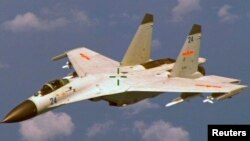Lost in the headlines about cybersecurity and climate change during the U.S.-China summit last week was the agreement struck between Presidents Barack Obama and Xi Jinping on rules for military air-to-air encounters.
The deal, which followed an earlier agreement on encounters between naval ships, is aimed at preventing encounters from escalating or causing crashes.
The new document, published on the Pentagon website, calls for safe conduct of military aircraft of either side, whether the encounters are unexpected or intentional.
Past encounters
In April 2001, a Chinese fighter jet collided with a U.S. EP-3 spy plane when conducting an interception over the South China Sea, resulting in the death of the Chinese pilot and the downing of the U.S. plane.
In another dangerous move that occurred in August last year, a PLA (People's Liberation Army) fighter jet intercepted and threatened a U.S. Navy P-8A reconnaissance plane at close range, again in international space over the South China Sea.
The Pentagon says it hopes the new air-to-air code of conduct can reduce the risk of another collision between the two militaries.
Citing successful implementation of the Code of Unplanned Encounters on the Sea, signed by the two sides in April 2014, Assistant Secretary of Defense David Shear told Congress this month that he hoped for more positive results from further engagement with China.
“These and other elements of U.S.-China defense diplomacy have yielded some positive results," he said. "U.S. and PLA navy vessels have now successfully employed the code for unplanned encounters at seas on multiple occasions.”
Doubts raised
However, Senator Jack Reed of Rhode Island, the senior Democrat on the Armed Services Committee, was cautious about what the agreements could do.
“While there has been some progress on the bilateral strategy to decrease tension between the U.S. Navy and the Chinese navy, through the establishment of new risk reduction mechanisms, such as engagement rules for air and maritime safety, our efforts to date do not seem to have an impact on China's aggressive tactics in the South China Sea,” he said.
Just days before Xi’s visit to the U.S., a PLA air force JH-7 aircraft operating over the Yellow Sea made a maneuver in front of a U.S. RC-135 surveillance plane that the U.S. crew regarded as unsafe.
Richard Weitz, senior fellow at the Hudson Institute, a domestic and foreign policy research group in Washington, said it was questionable whether the Chinese would fully implement the new agreement with the U.S.
“Some people in the military, some people elsewhere [in the government], are not going to implement that agreement," he said. "Then the question is: Is the government really trying to enforce it and is not doing that well, or is [Beijing] not going to enforce strongly and overlook the violations?” Weitz said.
Potential problems
Observers like Weitz say they believe one clause in the new code of conduct that is potentially very problematic involves U.S. reconnaissance missions in the South China Sea. It calls for one side to refrain from interfering with the activities in a warning zone declared by the other side, yet allows military aircraft to enjoy the rights and freedom of navigation under international law.
Weitz said that the difference in interpreting this rule by both sides could lead to dangerous consequences.
“Whatever the rules coming out of the Pentagon and the Chinese Ministry of Defense, when it gets to the level of the particular pilot or particular ground control officer, how they are going to interpret that, how they see the orders, what they see their mission is — that is different,” said Weitz.
The agreement calls for implementation in good faith and encourages airplanes encountering each other to communicate, yet does not require them to do so.
This report was produced in collaboration with the VOA Mandarin service.
